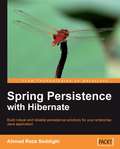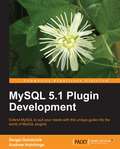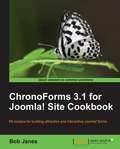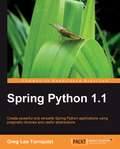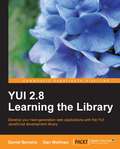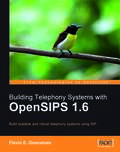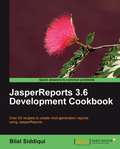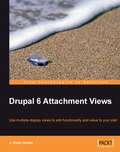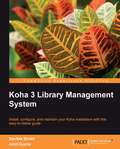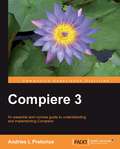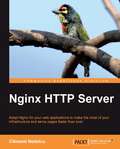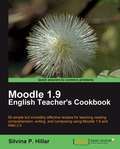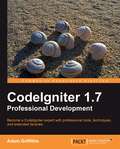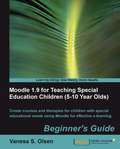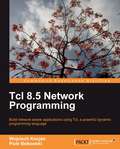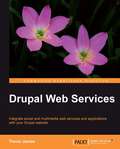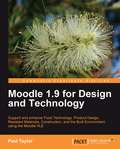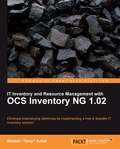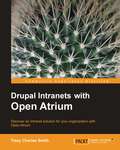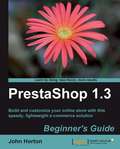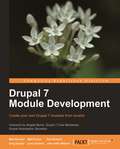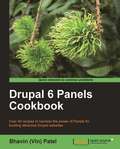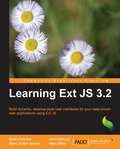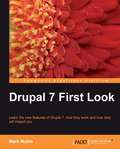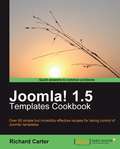- Table View
- List View
Spring Persistence with Hibernate
by Ahmad SeddighiSpring Persistence with Hibernate is an easy-to-follow, step-by-step, and example-rich guide to using Spring and Hibernate to build robust and effective Java applications. Furthermore, the book can be used as reference in areas where developers need help. All the topics explained in the book are demonstrated with practical examples and uncomplicated figures. The book is primarily for Spring developers and users who want to persist using the popular Hibernate persistence framework. Java, Hibernate, JPA, Spring, and open source developers in general will also find the book useful.
MySQL 5.1 Plugin Development
by Andrew HutchingsThis book is written in a hands-on style that actively involves you while you read through its chapters. In every chapter you, along with the author, will be implementing one or more fully working example plugins. The process is accompanied with a detailed step-by-step explanation of the code, at the same time providing you with resources to create your own plugins. If you are a MySQL application developer or a programmer who wants to interface with MySQL server, this book is for you. Basic knowledge of C/C++, SQL, and MySQL in particular is assumed in the book, but no deep familiarity with any of the topics is required.
ChronoForms 3.1 for Joomla! site Cookbook
by Bob JanesThis book is the missing manual for creating forms on your Joomla! site. Using simple examples that you can easily follow we will show you how you can create forms of almost any kind. Most of the chapters focus on one topic starting with simple recipes for new users and then adding new features that add more to the form but may also require more knowledge and experience to implement.Other chapters look in more detail at adding special features, or creating forms to perform particular tasks. Again the recipes range from those that a new user can easily implement to those that will help more advanced developers.Each recipe is kept as simple as possible and set out so that it can be easily implemented with the code supplied; and the recipes are also a set of building blocks that you can use to create much more complex forms using several recipes to build your form.As far as space allows we have explained how the code works, what features of Joomla or of ChronoForms we are using and we've offered suggestions in the 'There's more . . .' sections for ways in which the basic recipe can be extended or adapted.The code examples are complete and can be adapted by new users with the minimum of customization or they can be as a starting point for developers with more coding experience to build on and adapt to create fully customized form applications. This is a practical hands-on book for people who want to add forms to their Joomla! site. Whether you just want to add a simple newsletter sign-up form or a complex multi-page interactive form you'll find helpful suggestions and recipes that will get your forms working. Many recipes will work 'out-of-the-box' using ChronoForms built-in capabilities; other more advanced recipes require some knowledge of Joomla!, HTML, CSS ,PHP, MySQL or JavaScript. There is working code with each recipe that you can adapt to meet your specific needs.
Spring Python 1.1
by Greg Lee TurnquistThe book is an introduction to Spring Python. It starts with simple practical applications, moving on to more advanced applications with two advanced case studies at the end of the book. It is packed with screenshots, examples, and ready-to-use code making it very suitable for a beginner while also showing tactics and concepts suitable for the most experienced developers. Each chapter starts with a simple problem to solve, and then dives into how Spring Python provides the solution with step-by-step code samples. Along the way, screenshots and diagrams are used to show critical parts of the solution. The case studies start off with a handful of use cases, and then proceed step-by-step to incrementally develop features. Some use cases are left to the reader to implement as an exercise. Key problems discovered along the way are exposed and then solved, giving the reader the chance to solve them, or to read the author's solutions. This book is for Python developers who want to take their applications to the next level, by adding/using parts that scale their application up, without adding unnecessary complexity. It is also helpful for Java developers who want to mix in some Python to speed up their coding effort.
YUI 2.8: Learning the Library
by Dan Wellman Daniel BarreiroThe book is a tutorial, leading the reader first through the basics of the YUI library before moving on to more complex examples involving the YUI controls and utilities. The book is heavily example driven, and based around an approach of tinkering and extending to improve. This book is for web developers comfortable with JavaScript and CSS, who want to use the YUI library to easily put together rich, responsive web interfaces. No knowledge of the YUI library is presumed.
Building Telephony Systems with OpenSIPS 1.6
by Flavio E. GoncalvesThis is a practical, hands-on book based around a fictitious case study VoIP Provider that you will build on a development server using OpenSIPS 1.6. The case study grows chapter by chapter, from installing your local development server, right up to the finished VoIP provider. This book is for readers who want to understand how to build a SIP provider from scratch using OpenSIPS. It is suitable for VoIP providers, large enterprises, and universities. Telephony and Linux experience will be helpful but is not essential. Readers need not have prior knowledge of OpenSIPS. This book will also help readers who were using OpenSER but are now confused with the new OpenSIPS.
JasperReports 3.6 Development Cookbook
by Bilal SiddiquiThe entire book is a comprehensive collection of recipes meant to tutor you on making and enhancing reports. Each recipe provides you with easy step-by-step descriptions of the actions necessary to accomplish a specific task with explanations to help you to understand how and why each action was undertaken. Example values and code samples are used throughout the recipes, which makes adaptation for individual needs easy. Each recipe uses a concrete example for easy understanding. This book is for Java developers who want to use JasperReports to create user-friendly business reports. It is for those who may be familiar with JasperReports but want to dive into advanced JasperReports activities. If you know how to use Microsoft Word you can also learn how to design business reports using iReport by following the recipes of this cookbook. Although the primary audience of this cookbook are report designers, however Java and XML developers will find this book useful in understanding how Jasper's XML code works and how to wrap JasperReports functionality in your Java Swing or Web applications.
Drupal 6 Attachment Views
by J. Ayen GreenThis is a fun, informative, hands-on learning guide. It uses a real case study in an interactive and informal manner, and presents examples that continue to build on each other. Clear, concise instructions and practical examples mean you can learn quickly how to increase the functionality and value of your web site. If you are a Drupal developer of any level and you are waiting to explore Attachment Views, then this book is for you.
Koha 3 Library Management System
by Amit Gupta Savitra SirohiWritten in a practical style, this book uses the Linux shell in many chapters, demonstrating the execution of commands and their output. With liberal use of screenshots and plenty of code samples accompanied by careful explanation, it will make the task of installing and configuring Koha easy and straightforward. All chapters are written in a way that makes them applicable to various Linux distributions.This book is aimed at Linux system administrators who need to install and maintain Koha. If you are a system administrator who wants to set up an open source integrated library system, then this book is for you. It will also be useful for system administrators who require help with specific aspects of implementing Koha.
Compiere 3
by Andries L PretoriusThis book is a concise guide that focuses solely on implementing Compiere. It uses a business scenario case study throughout to illustrate the sort of decisions and considerations required at critical stages in a real-life Compiere implementation. If you are considering or want to easily implement Compiere in your organization, this book is for you. This book will also be beneficial to system users and administrators who wish to implement an ERP system. No previous knowledge of Compiere is required.
Nginx HTTP Server
by Clement NedelcuThe book includes detailed instructions for each of the processes it describes: downloading and installing the application, configuring and using modules, and much more. It provides a step-by-step tutorial to replace your existing web server with Nginx. With commented configuration sections and in-depth module descriptions, you will be able to make the most of the performance potential offered by Nginx. By covering both early setup stages and advanced topics, this book will suit web administrators interested in solutions to optimize their infrastructure, whether they are looking into replacing existing web server software or integrating a new tool cooperating with applications already up and running. If you, your visitors, and your operating system have been disappointed by Apache, this book is exactly what you need.
Moodle 1.9: The English Teacher's Cookbook
by Silvina P. HillarThis book follows a cookbook style, which will help you achieve outstanding results using ready-to-use recipes for reading comprehension, writing, and composition holding hands with Moodle 1.9 in the Web 2.0 Era. Each recipe is unique; some deal with similar teaching techniques, but they show how to develop the same technique using different software, situations, or topics. Images, videos, poems, songs, artists, classic stories, cartoons, superheroes, painting, the environment, and comics are inserted into the Moodle course, in order to be used as either prewriting or writing activities. If you are an English teacher who wants to discover practical, funny, and engaging activities to insert in your course, this is a perfectly designed book for you. It will help you to use different techniques in the teaching of reading comprehension, writing, and composition using a great variety of resources from the free and open source software available in the Web and interesting websites as well as social networks. You need basic experience with Moodle 1.9 or 1.9.5, as well as installation and configuration procedures.
CodeIgniter 1.7 Professional Development
by Adam GriffithsThis book is a practical guide that takes you through a number of techniques. Each chapter builds upon knowledge from the previous chapter. Step-by-step instructions with examples and illustrative screenshots ensure that you gain a firm grasp of the topic being explained. This book is written for advanced PHP developers with a good working knowledge of Object Oriented Programming techniques who are comfortable with developing applications and wish to use CodeIgniter to make their development easier, quicker, and more fun. Basic knowledge of CodeIgniter will be helpful. This book will suit developers who fall into three categories: Professional Developers - employees of a software house or organization with in-house software development, Freelance Developers - solo developers working in the industry on their own, Just-for-fun Developers - people working with PHP building web applications is their spare time for fun
Moodle 1.9 for Teaching Special Education Children (5-10): Beginner's Guide
by Vanesa S. OlsenWritten with a step-by-step but friendly and engaging approach, this Packt Beginner's Guide is designed to be placed alongside the computer as your guide and mentor. Step-by-step tutorials are boosted by explanations of the reasoning behind what you are doing. You will quickly pick up the necessary skills, tips, and tricks for creating practical exercises using Moodle 1.9 with practical examples and see how the child with special education needs progresses. If you are an SEN teacher or SEN therapist with minimal knowledge of Moodle who is willing to exploit Web 2.0 possibilities using Moodle 1.9 as the background platform, this book is for you.
Tcl 8.5 Network Programming
by Wojciech KocjanThe book is written so that both experienced and novice Tclers can find useful information inside. It starts with quick introduction to Tcl and its networking support for those who are less familiar with them. Authors focus on showing practical, yet simple examples for each module and command described so that reader understands how to use them when solving the real life problems. The examples given are useful programs that try to solve real-world needs. All sample programs are clear and concise yet nothing essential is left out and the programming style focuses on readability rather than on stylistic rigor or efficiency. This book is for Tcl developers with basic network programming concepts, who want to add networking capabilities to their applications. Working knowledge of Tcl and basic experience of network protocols will be useful. The reader should be familiar with basic concepts used in modern networking - keywords like TCP, HTTP or XML should not be a mystery. The book does not require advanced knowledge of Tcl - the first chapters will swiftly introduce the reader into it, allowing refreshing the information or gaining a quick overview of the Tcl language abilities.
Drupal Web Services
by Trevor JamesA practical hands-on guide to integrating Web services with your Drupal Web site. It will start from basic understanding of web services to how your Drupal site can be integrated with web applications using web services.If you're are a Drupal user, webmaster, or an administrator who wants to integrate Flickr, Facebook, Twitter, Amazon, LinkedIn, Kaltura and Mollom with your Drupal site then this book will be a good addition to your Drupal library.You do not need to have programming experience to use this book. Drupal Web Services is written for anyone who works with Drupal on a daily basis.
Moodle 1.9 for Design and Technology
by Paul TaylorThis book has real-world samples of how to solve problems related to Design and Technology and offers tips on how to enhance the use of Moodle to get the most out of the subject. Worked examples will act as a base from which to build complex and exciting courses for students in all age ranges and abilities. If you are a Design & Technology teacher, teaching assistant, head of department, SMT, or IT technician in school and would like to use Moodle to design, create, or administer a VLE for Design and Technology, this book is for you. You need to know the basics of Moodle for teaching and learning and should have some experience with Design and Technology.
IT Inventory and Resource Management with OCS Inventory NG 1.02
by Barzan Tony AntalThis book closely follows the style of a practical, hands-on "how to" guide on working with OCS Inventory NG. The step-by-step approach, coupled with the use of visual aids, clear instructions, and real-world examples, makes it a fast-paced book. Upon the completion of this book, you will have the necessary skill set, know-how, and confidence to implement OCS Inventory NG to meet the demanding asset management needs of any organization. Then you can carry on using the book as reference material. This book targets an audience of system administrators and IT professionals who are required to implement, configure, customize, and work with IT Inventory and Asset Management solutions. The book does not presume any prior knowledge of inventory management, just a solid grasp of the server/client model and familiarity with the chosen operating system along with the necessary web server and database server terminologies. Anyone with an interest in inventorying IT assets and solving real-world resource management dilemmas will enjoy this book.
Drupal Intranets with Open Atrium
by Tracy SmithPacked with screenshots and clear instructions, this book allows you to follow along with your own site and ensures you won't get lost. It's a how-to guide that guides you simply through each step.This book is intended for beginning to intermediate computer users who either have not worked with Drupal before or want to expand their Drupal knowledge by installing Open Atrium. If you want to learn how to quickly set up an intranet to improve your organization's communication and workflow, then this book is for you.
PrestaShop 1.3 Beginner's Guide
by John HortonThe book is structured so that following the chapters in order leads to building a fully functioning and live trading PrestaShop. Guidance is also given should you wish to learn or practice your skills in an offline, non-trading environment. Every chapter contains clearly structured and illustrated step-by-step explanation to achieve the goals discussed. Nothing is left for readers to work out themselves, but it would be very simple for them to use the information to go beyond the specific tutorials, should they wish to do so. There is optional additional reading, including more than a dozen specifically written downloadable e-books made available on the book's support website just for readers of PrestaShop 1.3 Beginners Guide. This book is for anybody who wants a fully functioning e-commerce store using PrestaShop. You do not have to have any previous knowledge of PrestaShop or any aspect of e-commerce or business in general. If you do, then you will probably find this guide really valuable as well. The book covers all you need to know about starting your own e-commerce business.
Drupal 7 Module Development
by John Wilkins Matt Butcher Larry GarfieldThis book takes a hands-on, practical approach to software development. The authors, all professional Drupal developers and contributors to the Drupal project, provide accessible coding samples designed to exhibit not only the technical merits and abilities of Drupal, but also proper architectural and stylistic approaches to coding on one of the world's most popular content management systems. Every chapter provides fully functional code samples illustrating the APIs and strategies discussed in the chapter. With this foundation, developers can quickly build sophisticated tools on their own by making use of the strategies and techniques exemplified in this book. If you are a PHP developer or a Drupal user looking to dive into Drupal development then you will find this book an excellent introduction to coding within Drupal. Those with some Drupal experience will also find this an invaluable tool for updating their knowledge about the powerful new features of Drupal 7. Theme developers looking to extend their abilities will find this an accessible introduction to PHP coding within the Drupal environment. This book assumes that you are familiar with basic PHP programming, along with HTML and CSS. No experience with programming Drupal is required, although it is also a handy way for experienced Drupal developers to get up to speed with Drupal 7.
Drupal 6 Panels Cookbook
by Bhavin PatelWritten in cookbook style, this book offers learning and techniques through recipes. It contains step-by-step instructions for Drupal users to make optimum use of the Panels module. The book is designed in such a way that you can refer to things chapter by chapter, or read them in no particular order. If you are a Drupal developer wanting to use Panels to enhance the attractiveness of your website and make it impressive, this book is for you. Knowledge of running a Drupal site is required.
Learning Ext JS 3.2
by Shea Frederick Colin Ramsay Nigel White Steve 'Cutter' BladesThe book provides plenty of fun example code and screenshots to guide you through the creation of examples to assist with learning. By taking a chapter-by-chapter look at each major aspect of the Ext JS framework, the book lets you digest the available features in small, easily understandable chunks, allowing you to start using the library for your development needs immediately. This book is written for Web Application Developers who are familiar with HTML but may have little to no experience with JavaScript application development. If you are starting to build a new web application, or are re-vamping an existing web application, then this book is for you.
Drupal 7 First Look
by Mark NobleThis hands-on guide takes a look at the main functional areas of Drupal that have significant new features. It explains these new features and how to use them, drawing attention to significant differences from how things used to behave, and giving the reader an idea of the kind of consequences these changes will bring to them.Drupal 7 First Look is written for site administrators, themers, and developers who have some experience with Drupal 6 (or even Drupal 5) and want to upgrade their sites, themes, or modules to Drupal 7 or just learn more about Drupal 7. No programming experience is required, but several code examples are covered for readers that want more in-depth information about building themes and modules.
Joomla! 1.5 Templates Cookbook
by Richard CarterJoomla! 1.5 Templates Cookbook contains step-by-step instructions for Joomla! users to customize their Joomla! templates. The book is designed so that you can refer to it chapter by chapter, or you can look at the list of recipes and read those that interest you in no particular order. This book is written for Joomla! developers who want to improve the look and feel of their Joomla! sites. Readers are expected to have knowledge of CSS and (X)HTML. Although it will be helpful, no prior knowledge of Joomla! theming is expected.
